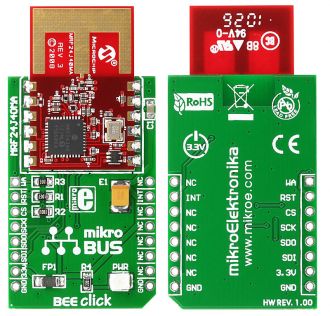
We strongly encourage users to use Package manager for sharing their code on Libstock website, because it boosts your efficiency and leaves the end user with no room for error. [more info]

Rating:
Author: MIKROE
Last Updated: 2019-07-29
Package Version: 1.0.0.1
mikroSDK Library: 1.0.0.0
Category: ZigBee
Downloaded: 13532 times
Followed by: 1 user
License: MIT license
This project is a simple demonstration of working with the BEE click board.
The on-board MRF24J40MA is a 2.4 GHz IEEE 802.15.4 radio transceiver module and operates in the 2.4GHz frequency band.
Do you want to subscribe in order to receive notifications regarding "BEE click" changes.
Do you want to unsubscribe in order to stop receiving notifications regarding "BEE click" changes.
Do you want to report abuse regarding "BEE click".

Front and back view of BEE click board designed in mikroBUS form factor. mikroBUS is specially designed pinout standard with SPI, I2C, Analog, UART, Interrupt, PWM, Reset and Power supply pins.
View full imageLibrary Description
The library covers all the necessary functions to control BEE click board. The library performs the communication with the device via SPI driver by writing to registers and by reading from registers.
Key functions:
void bee_writeByteShort( uint8_t regAddress, uint8_t writeData ) - Write the byte of data to the short register address function.uint8_t bee_readByteLong( uint16_t regAddress ) - Read the byte of data from the long register address function.void bee_readRxFIFO( uint8_t *rxData ) - Read RX FIFO function.Examples description
The application is composed of the three sections :
void applicationTask()
{
if( bee_interruptActivity() )
{
tmp = bee_readByteShort( _BEE_INTSTAT );
bee_readRxFIFO( &rxData );
Delay_100ms();
if ( rxData[ 0 ] != rxDataOld )
{
ByteToStr( rxData[ 0 ], logText );
mikrobus_logWrite( logText, _LOG_LINE );
rxDataOld = rxData[ 0 ];
}
}
}
Other mikroE Libraries used in the example:
SPIUARTConversionAdditional notes and informations
Depending on the development board you are using, you may need USB UART click, USB UART 2 click or RS232 click to connect to your PC, for development systems with no UART to USB interface available on the board. The terminal available in all MikroElektronika compilers, or any other terminal application of your choice, can be used to read the message.